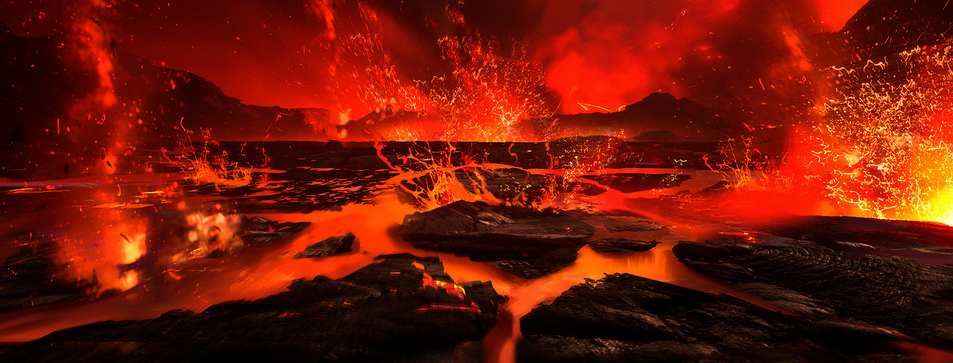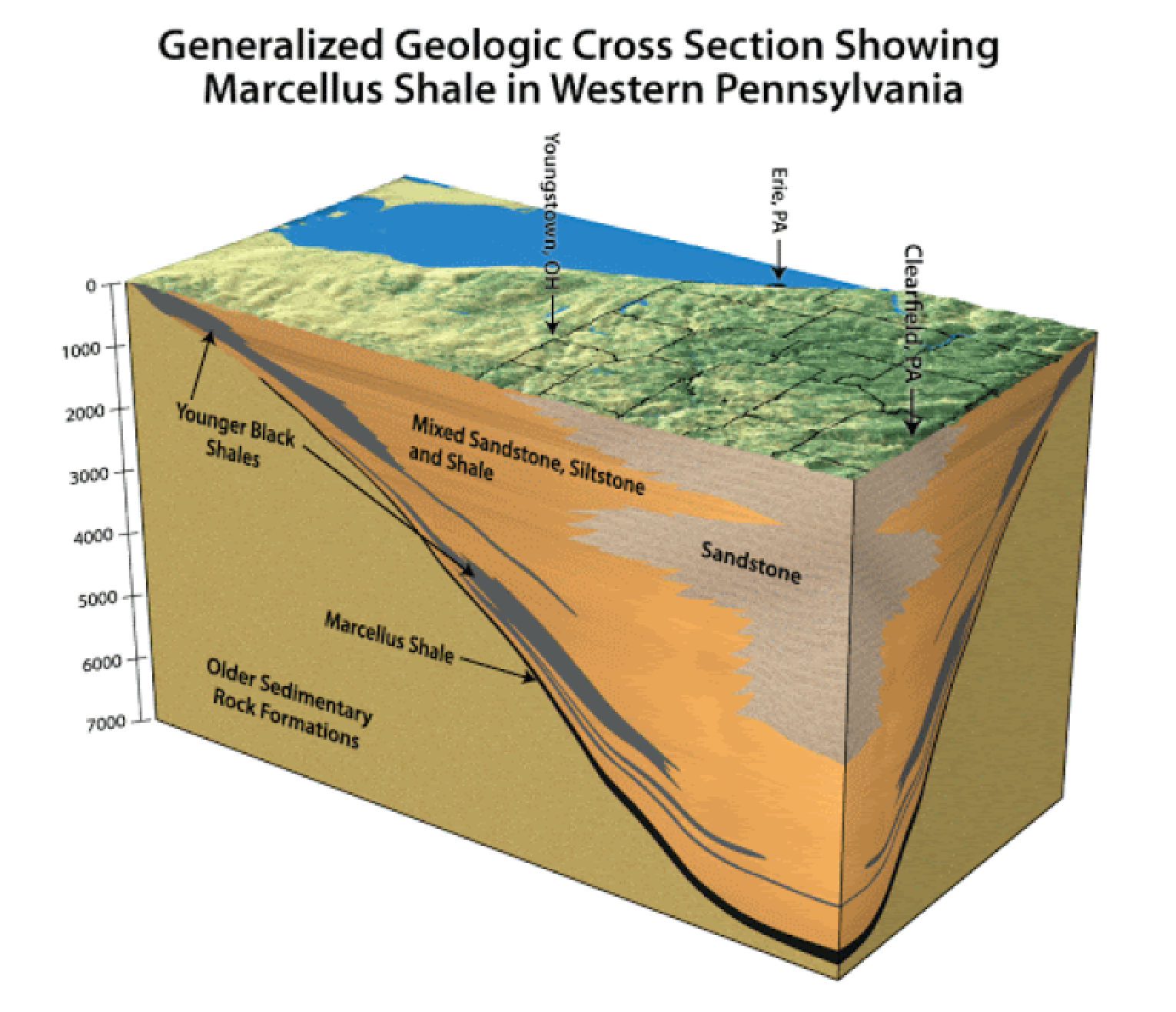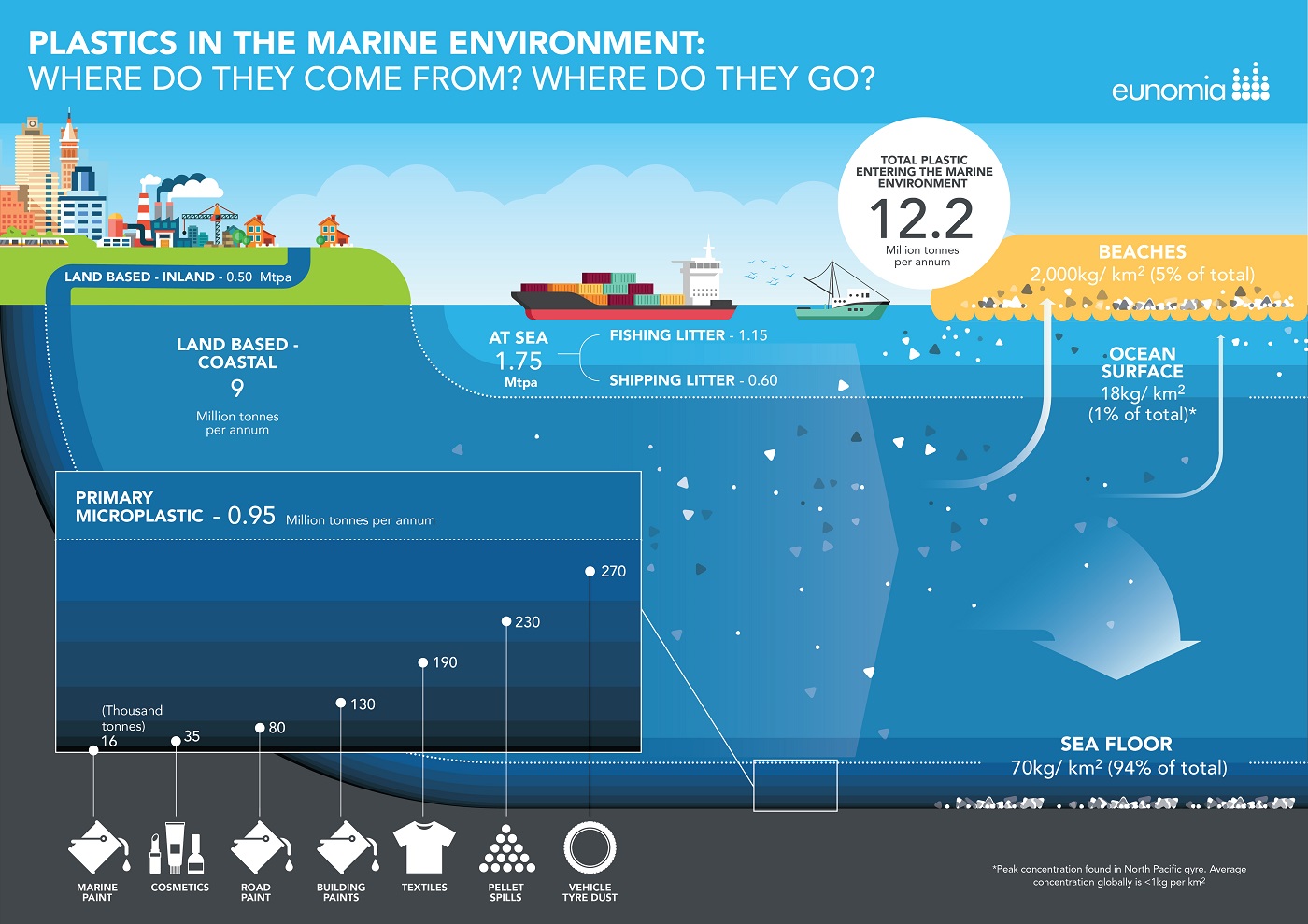
Darek Zabrocki, 'Early Earth.' Framestore/National Geographic. [o]
Four and a half billion years ago, or thereabouts, there was nothing but a hot, rocky, lifeless mass bathed in water vapor, ammonia, hydrogen and methane. After seven-hundred million years, the Earth had cooled sufficiently for the water vapor to condense and become an ocean. And still there was no plastic.
A little over half-a-billion years ago, layers of dead phytoplankton, algae and primitive marine organisms that had begun living in the ocean drifted to its floor and were trapped in mud and sand. Over geologic ages, through heat and pressure, these layers of decayed organic material became oil and liquid gas trapped beneath the earth’s surface of rock and clay. And still there was no plastic.
But its feedstock was now commingled within the seams, pools, shale beds, and seeps of fossil biomass — the hydrocarbons that had trapped the solar energy of an ancient world. The simplest of all the hydrocarbons was methane, encapsulated as a liquid gas from vapors released by the rotting carcasses of tiny sea creatures and, over time, larger, more complex organisms. Out of the simple methane molecule — in those dark, cloacal spaces, with the addition of a single carbon atom, variously configured — were created ethane, propane, and butane.
New modes of knowledge unfolded that aimed at making nature external — the better that it could be subordinated and rationalized, its bounty extracted, in service to capital and empire.
Swept up in the ‘Great Acceleration’ — the post-war decades of excessive consumption, extravagant leaps in technology, profligate waste and CO2 emissions — this consummate material of modern materialism birthed Global Plastic, a circumstance in which, like Global Warming, we, and all other beings, now live and breathe.
Today, these feedstocks — sourced from hydrocarbon gas liquids (HGLs) and derived from natural gas — are turned into plastic pellets, or nurdles, which are the raw material of finished plastics. The United States is currently undergoing a so-called ‘Resin Boom’, with manufacturers daily producing trillions of the lentil sized pellets, which are mostly shipped to Asia. Pellet ‘loss’, in production and shipping, is now a major source of global plastic pollution. Nurdles, likely to be found in their hundreds on the beach nearest you, are but the latest reification of our plundering of the earth’s subterranean store of hydrocarbons.
Peat, a coal precursor, formed by decayed organic material lying close to the Earth’s surface and partially digested in acidic and anaerobic peatland ecosystems, has been harvested as a fossil fuel since the human discovery of fire. The unlikelihood of a flammable square of turf cut from a bog, was, much later, matched by the discovery of sedimentary rocks that would burn. Coal then become the first hydrocarbon to be mined, and its use as a fuel dates back at least three millennia to China. In Europe, it was used by the Romans to heat, among other things, the water in their elaborate bathing facilities. Today, a large part of its historical notoriety is linked to it fueling, in a very literal sense, Europe’s Industrial Revolution.
From the beginning, fossil fuels have been sought out as alternative sources of energy to less tractable resources. Thus, in the second half of the nineteenth century, site-specific water mills were replaced by coal-powered steam engines that could be located in areas of cheap labor, and lamp-oil sourced from whale carcasses was replaced by oil distilled from petroleum. The first widely used plastic was celluloid, which used plant-based polymers. Polymers are large molecules made up of long chains of smaller molecules called monomers. They provide the strength and flexibility, or plasticity, inherent in the cellulose that makes up the cell walls of plants. These natural polymers are also found in hair, silk and DNA.

Nurdles, the raw material of finished plastics, are a blight of the ‘Resin Boom’. [o]
It was the polymers present in hydrocarbons, however, that held the promise — at the start of the twentieth century — of a vast world of plastics. The first to be made, in 1907, was Bakelite, from coal tar, which was initially designed to replace shellac, sourced from Asian beetles, and used in electrical insulation. It was quickly developed as a key material in the burgeoning consumer goods market; it was used to encase radios, telephones and clocks, and made into housewares and jewelry.
In 1920, Union Carbide (now Dow Chemical) established the first steam-cracking plant in West Virginia, specifically to produce ethylene — a short polymer petrochemical with a wide range of industrial applications — but none as epochal as the production of polyethylene. Still dominated by Bakelite, the plastics industry was slow to respond. After 1929, development was constrained by the Depression, but Wallace Carothers, working for Du Pont, developed an artificial rubber, neoprene, in 1931, and nylon in 1938 — both of which were militarily significant materials. Consequently, the production of plastic metastasized during World War II. Fueled by the post-war economic boom and an excess of production capacity, it quickly became the preeminent material in consumer products, clothing, packing materials and food storage.
Swept up in the ‘Great Acceleration’ — the post-war decades of excessive consumption, extravagant leaps in technology, profligate waste and CO2 emissions — this consummate material of modern materialism birthed Global Plastic, a circumstance in which, like Global Warming, we, and all other beings, now live and breathe. The Earth’s atmosphere had become a dumping ground for its greenhouse gases and its oceans a sink hole for its discarded plastics.
The evidence mounts of the apocalyptic significance of Global Plastic. As an acknowledged endocrine disruptor, the material penetrates creatures through their skin, in the air they breathe, the water they drink, and the food that they ingest. Yet, the devastating consequences of a material that refuses to decompose — and is recalcitrant in all attempts to be recycled (90.5% goes unrecycled, world-wide) — is being produced in ever increasing quantities. And, in its discarded after-life it threatens to colonize the lands and oceans of the planet, and remains overshadowed by that enclosing cloud of upper atmosphere CO2, which is, to coin a phrase, sucking all the oxygen out of the room.
For now, Global Warming dwarfs the perceived exigencies of Global Plastic. All the while, the production of plastic, from hydrocarbon to finished material, contributes greatly to global CO2 emissions and is expected to reach 17% of the global carbon budget by 2050.
Those in the business of proclaiming ecological disaster have a professional interest in assuring their audience that there is still hope amidst the encyclopedic evidence they present to the contrary: that change can occur without radically re-thinking the world and our place within it; and that state sanctioned planetary predation, of which the subterranean extraction of hydrocarbons is but a part, can continue without fatally compromising the viability of the world. Greta Thunberg speaks her dark and eerie truth to power, uncompromisingly pure in her walking of her talk. But the single-minded focus on CO2 emissions, that she and others profess, has shaped our concerns for the environment so that the clearly observable anthropogenic changes to the climate have become the dominant trope in our visions of the apocalypse. The terrestrial threat of a planet wrapped in plastic waste, sourced from the same hydrocarbon plunder that generates CO2, has been slow to infiltrate our primal fears for the survival, in recognizable form, of the earth’s natural systems.

Oil Creek, Pennsylvania, 1864. [o]
It is now apparent that our failure to maintain a sustainable, naturally regenerating environment which we share with all other human and extra-human beings is the result of a systemic flaw in the way we have organized our hegemonic, First World, human-privileging societies. It is not just the extinctions and the loss of wild-life habitat for those species that remain; the ubiquity of plastic waste on land and sea; the micro-plastics in our bodies, our water, and the micro-fibers in the wind; the ever-rising levels of CO2 in the atmosphere; the fires, the rising sea-levels, the pollution, and the droughts and other consequences of extreme weather. These are but the symptoms of a profound misunderstanding of our place in the world.
It is a misunderstanding that has as its consequence the widely touted prediction that by 2050, there will be more plastic in the world’s oceans, by weight, than fish.
It is a misunderstanding that has, as its consequence, seeds, plants and animals washing up on shores where they are not native by inadvertently riding the oceans currents on windblown aggregations, or rafts of plastic waste to devastate the finely balanced ecosystems where they land.
It is a misunderstanding that has as its consequence the clear plastic bag which strangles birds, asphyxiates small children and is mistaken for food by marine life, while being freely dispensed at your local Farmers Market to be filled with organically grown fruits and vegetables.
It is a misunderstanding that has resulted in the choking of the San Francisco Bay with micro-plastics generated from plastic waste made brittle by the sun and then abraded by wind and tides, and from rubber and neoprene marbles thrown off by tires on the twisting, vertiginous streets that surround the bay.
It is a misunderstanding that has created the vast garbage patch of plastic waste in the North Pacific Gyre between California and the Hawaiian Islands where discarded drift nets, called ghostnets, and other commercial fishing gear, swirl amidst the microplastic soup.
It is a misunderstanding that has as its basis the intellectual separation of Nature and Society. The seeds of this toxic binary were planted over five hundred years ago and now, grown vast and enveloping, it is a construct that poisons the way of being in the world for all those who live under the sway of modernity.

The plastic pellets produced from hydrocarbon gas liquids is helping sustain the boom in fracking. [o]
Jason W. Moore, in Capitalism in the Web of Life, Ecology and the Accumulation of Capital (2015), notes that the “New modes of knowledge, bookended by Copernicus and Newton (c. 1470s-1720s) …unfolded within a historical project that aimed at making nature external — the better that it could be subordinated and rationalized, its bounty extracted, in service to capital and empire.” This new way of being in the world emerged out of the decline of feudalism — that reasonably communitarian system that ensured some level of cooperation between lord and peasant, and they with the land on which both depended. This relationship, which lasted in Europe from the ninth century to the fourteenth, limited environmental devastation despite a slowly rising population in the Medieval Warm Period, 950-1250. But escalating class struggles, intensified warfare and cultural destabilization slowly eroded feudalism, its decay exacerbated by the Black Death, 1347-1352, which killed a third of the population. In the fifteenth century, Europe’s slow expansion of its frontiers beyond its continental landmass profoundly impacted the old comity, and after the discovery of the Americas, in 1492, it was fatally wounded.
As Moore reports, “By the end of the sixteenth century, a tipping point had been reached — a new ethic developed that sanctioned the exploitation of Nature.” This was confirmed by Francis Bacon’s establishment of the empirical scientific method, and later by the Cartesian charge that mankind can “…make ourselves, as it were, the masters and possessors of nature”. Thus, was born a materialism based on a scientific and economic rationalism that demanded the separation of humans from the rest of the natural world. Successive waves of imperialism greatly expanded the territory on which this freshly sanctioned predation could occur, and fueled agricultural and industrial revolutions which, in turn, enabled vastly increased through-puts of labor, food, energy and raw materials. It was in this matrix that the institution of slavery could be considered rational, and that later the vastly expanded extraction of fossil fuels, after the invention of the steam engine, would become inevitable. Both events are inextricably linked with the contemporary development of capitalism.
Moore points out that what he terms ‘bio-prospecting’ has been practiced in the period from Columbus to Monsanto and Exxon. These activities are typically supported by states in pursuit, in his lexicon, of ‘geo-power’, the control of natural resources that bolster their economic strength. It is in this pursuit that the United States has expended vast amounts of treasure to protect American oil interests in the Middle East, and vast sums, too, in the development of technologies to access this country’s unconventional oil and gas reserves.
The plastic pellets produced from hydrocarbon gas liquids have made the production of natural gas a new focus of the U.S. oil and gas industry and is helping sustain the boom in fracking. Seventy percent of U.S. natural gas is now fracked from shale deposits such as the Marcellus formations beneath Ohio, West Virginia and Pennsylvania, along with the Permian, Woodford, Barnett, and Eagle-Ford formations in Texas, as well as North Dakota’s Bakken shales. The Monterey formation that runs down the spine of California, from Sacramento to Los Angeles, holds two-thirds of the nation’s shale oil and gas reserves. It has, thus far, been saved from extensive fracking by its complex geology, local activism, and the fact that much of it is under the state’s prime agricultural land. But the Monterey shale, and other unexploited formations, remain forever vulnerable to advances in extraction technology and increased demand.
The U.S. is now eclipsed by those regions that have fallen under the pall of its cultural influence.
The boom in fracking would not have been possible without new computer-controlled drilling and ballistics technologies, together with innovative chemical formulations developed with the financial assistance of the U.S. Department of Energy. The state has, in effect, joint-ventured with private enterprise in plundering the shale that lies beneath the United States. This plunder is founded, as Moore and others show, on debasing the value of the natural world. It represents a strategy of terrestrial violence that asserts our dominion over the planet. The value of leaving hydrocarbons in the ground now — gold and silver back in the day; or of leaving the rich biodiversity of the prairies untouched — is, and always has been, discounted to zero, except by the continent’s pre-modern Indigenous peoples.
The genocidal impact of colonial exploitation, beginning late in the fifteenth century, is widely understood as a fundamental part of the history of the Americas, but the blowback that impacted its imperial perpetrators, while less often considered, was not inconsequential. The importation of vast quantities of precious metals into Spain and Portugal resulted in a massive financial inflation that led directly to several centuries of economic immiseration on the Iberian Peninsula. This blowback from the mining of hydrocarbons is global, and we are beginning to understand that it extends, in this country, beyond the well-documented impacts of the production and burning of fossil fuels. It extends to the fracking, cracking and polymerization of hydrocarbon gas liquids, which are responsible for significantly adding to the global supply of plastic pellets — and, in turn, for the waste generated by finished plastic products.
While colonialism always relied on the development of new technologies appropriate to transportation, food production, social controls and the building of urban settlements, computerized control systems have now vastly expanded the range and impact of humankind’s predation. Moore notes that: “At the core of the capitalist project, from its sixteenth century origin, was the scientific and symbolic creation of nature in its modern form, as something that could be mapped, abstracted, quantified, and otherwise subject to linear control.” Computer-controlled fracking operations serve as the apotheosis of this concept, enabling the economically efficient extraction of natural gas from shale and similarly facilitating the production of plastic pellets.
Over 300 new plastic production facilities are currently proposed in the U.S. giant plant planned by Royal Dutch Shell for Pittsburgh. But it is the Gulf Coast from Houston to New Orleans and up the Mississippi River to Baton Rouge that is currently the ground zero of the massive congeries of industrial infrastructure devoted to the processing of the fracked hydrocarbon gas liquids into synthetic polymers. The distillates run directly from the shale fracking fields through pipelines that riddle the eastern two-thirds of the United States — and through the Cochin pipeline which snakes north to Alberta. They travel to coastal processing plants, where they are ‘fractionated’ to separate the ethane, propane, and butane. The separated gas liquids are then pipelined to other facilities nearby, where they are polymerized (the process of forming polymer chains) and turned into plastic resin pellets. Packed in 55 lb. bags, the nurdles fit comfortably, beanbag-like, into forty-foot shipping containers. Typically shipped directly from the Gulf ports to Singapore, they are trans-shipped to other Asian destinations. Finished plastic goods return from those same destinations, often in the same containers, to the U.S. market.


Forbes article naming Coca-Cola worst polluter in plastics audit . . . accompanied by Coke ad. Uh, feel good to be so out of it? [o]
Annual consumption of the pellets is projected to double in the next decade to over half a billion tons, and production capacity continues to grow in the petrochemical industrial ghettos of Texas and Louisiana. There, they are interspersed with prototypical, mostly black and brown, frontline communities, in areas vulnerable to flooding and rising sea-levels, where toxins lie heavy in the air and vicious colloidal dispersions paint rainbows on the streets. These are the quintessential environments of slow violence in which the early-twentieth century chemical engineering triumphs of Union Carbide are substantiated on a massive scale, and where the poor and middle classes are oppressed by the rabid feeding of nurdles into Global Plastic’s supply chain.
Like Global Warming, Global Plastic is a planetary phenomenon, but the U.S. has an outsized responsibility for both. While the emergence of capital accumulation driven by fossil fuels first occurred in the second half of the nineteenth century — in the British Isles amidst Blake’s ‘dark satanic mills’ — the contribution of the U.S. to greenhouse gas emissions in the twentieth century was realized both in the metrics of its oil production and in the grotesque levels of consumption to which the rest of the world, then and now, aspires. While the U.S. is no longer the primary global source of greenhouse gas emissions, it has taught the world well and is now eclipsed by those regions that have fallen under the pall of its cultural influence.
Crude oil production in the U.S. reached a peak around 1970 of ten million barrels a day. It then suffered a precipitous decline before flat-lining until 2008 when the shale fracking revolution radically increased this country’s hydrocarbon output. Since 2014, it has been the world’s largest hydrocarbon producer, outstripping its nearest competitors, Russia and Saudi Arabia. As a part of this expansion, the U.S. now produces more than 20% of the world’s plastic, and its production continues to increase, fueled by ever cheaper fracked natural gas.
Perhaps the greatest damage that America has wrought, in terms of planetary degradation, is in its vast media outreach that has consistently advertised a high-consumption lifestyle. That consumption now comes wrapped in, or is largely made of plastic, and often both. Packaging consumes from between 35%-45% of the global production of synthetic polymers; construction another 16%; textiles 15%; and transportation and electronics a further 10%. Plastic is essential, at this moment, in the packaging of our food, the building of our shelter, the production of our clothing, computers, telecommunications and transport, and in our healthcare where wellness is dispensed in plastic vials, IV bags, tubes and syringes; our sundered vitals sewn with nylon thread. We are surrounded by the corporeal presence of plastic. Buck Henry’s line from the 1967 film, The Graduate, spoken by a middle-aged wanna-be career coach to the eponymous young man, played by Dustin Hoffman — “I want to say one word to you. Just one word. Plastics.” — is a nostrum that, although eschewed by Hoffman’s character, has now been heeded around the world.

Societal and environmental disregard in its many forms . [o]
Geographic particularism is irrelevant when considering phenomena which are truly global. Global Plastic is a toxic emanation that enfolds the earth. While it is the direct result of the exploitation of a widely dispersed fossil biomass, the U.S. remains the avatar of those societies of mass-consumption and a throw-away ethos in which its plastic end-products are now so pervasive.
Given the time it takes to biodegrade: In the End, there will be plastic. Even if production were to stop today it would still be with us in the fourth millennium. The legacy of the modern world — of, let us say, the last five hundred years — is a warming atmosphere preternaturally laden with CO2. It is a planet with a plastic bestrewn surface, plastic saturated seas, and with winds, waves, rocks and tides grinding brightly colored polymers into toxic grains, fated to be embedded in the geologic layers of the Anthropocene.
It is a legacy based on the manipulation of those looted hydrocarbons, created in ages past and now in the modern world, transformed into multiple agents of biospheric destruction. This tragic inheritance is founded on a misunderstanding of our place in the world — a misunderstanding that now, perhaps, with its consequences fully apparent, we are beginning to comprehend. ≈ç

JOHN DAVIS is a California-based architect who also writes a blog, Urban Wildland. He lives in the Upper Ojai. This article was commissioned by CounterPunch.

Add new comment